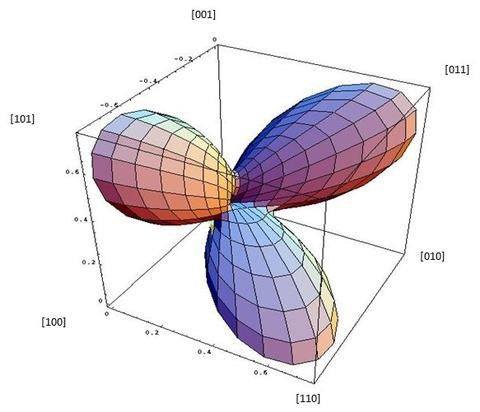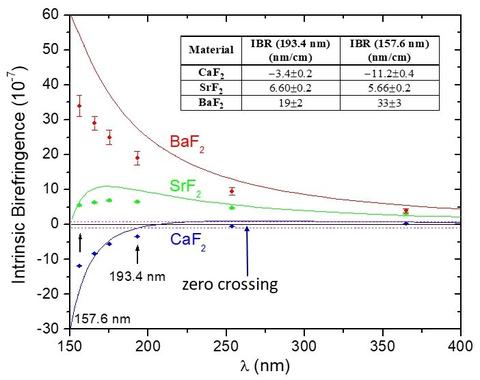Summary
This program is directed towards characterizing the birefringence properties of optical materials for the wavelength range 0.12 μm – 15 μm. The birefringence investigated comes from three sources: 1) crystal structure asymmetry, 2) stress-induced birefringence (grown-in or externally applied), and 3) spatial-dispersion-induced (crystal-symmetry-breaking from finite photon momentum k at short wavelengths.)
Description

Fig. 1. Angular dependence of the magnitude of spatial-dispersion-induced (intrinsic) birefringence for the cubic crystal CaF2, relative to the crystal-axes directions.
For crystals with non-cubic crystal symmetry, we make accurate measurements of the birefringence and its wavelength dispersion (0.12 μm – 15 μm) by separate index measurements of the two polarizations using the NIST's minimum deviation refractometry system.
In nominally isotropic materials (cubic crystals or non-crystalline materials), birefringence can occur due to grown-in stress. This affects the optical properties. We map out the residual birefringence by making local polarimetry measurements (0.12 μm – 2 μm) and scanning these over the material.
For crystalline and non-crystalline materials, we determine the dependence of birefringence on externally applied stress, the stress-optic coefficients, (0.12 μm – 2 μm). Specially prepared samples (crystallographically-oriented for crystalline materials) are subjected to calibrated stress applied by a custom uniaxial stress apparatus. The resulting birefringence is characterized using polarimetry and interferometry for various propagation directions through the stressed material.

For crystalline materials, there is another source of birefringence due to the breaking of the crystal symmetry by the finite value of the photon momentum k at short wavelengths near the absorption band edges. Though this effect was recognized and first measured a century ago, the magnitude was so small that it was not considered to have any practical impact. Our project was the first to measure this spatial-dispersion-induced (intrinsic) birefringence effect (IBR) in technologically important visible and ultraviolet optical materials and the first to develop a detailed analysis, showing that it indeed could have a significant impact on precision optical instruments, such as advanced semiconductor optical lithography systems. The symmetry of the effect is shown in Fig. 1. Our measurements for the key ultraviolet optical materials CaF2, BaF2, SrF2 are shown in Fig. 2. Our results and analysis solved the problem of why prototype193 nm optical lithography systems were not performing to design specifications, and this compelled a redesign of 193 nm optical lithography systems to minimize and correct for the effect. Our results also forced a reconsideration of the development of the next generation 157 nm optical lithography, which was ultimately cancelled, in part due to the difficulties imposed by this effect.
Our project continues to make IBR measurements on potentially important visible and ultraviolet optical materials, identified by us in anticipation of a possible optical technology issue and on materials requested by industry customers.

